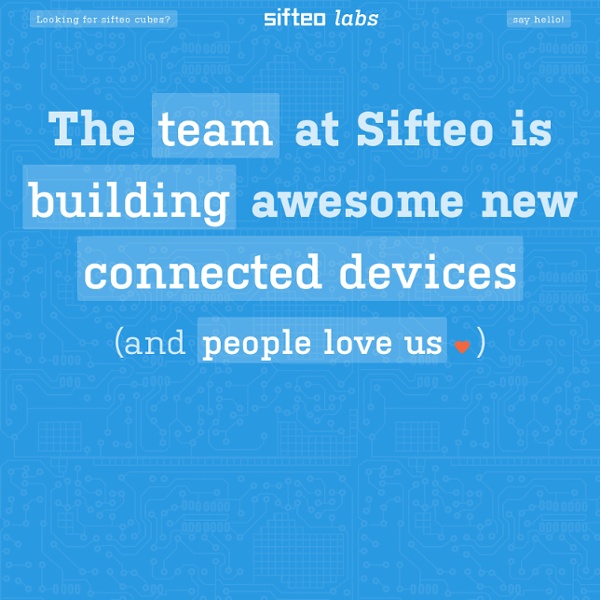



Hole-In-Space, 1980 HOLE-IN-SPACE was a Public Communication Sculpture. On a November evening in 1980 the unsuspecting public walking past the Lincoln Center for the Performing Arts in New York City, and "The Broadway" department store located in the open air Shopping Center in Century City (LA), had a surprising counter with each other. Suddenly head-to-toe, life-sized, television images of the people on the opposite coast appeared. They could now see, hear, and speak with each other as if encountering each other on the same sidewalk.
Inventor's Guide - VEX Wiki From VEX Wiki 2008 VEX Inventor's Guide Complete 2008 VEX Inventor's Guide (27M pdf, 07-22-2008)Introduction (0.7M pdf, 06-27-08)Structure (3.2M pdf, 06-27-08)Motion (6.6M pdf, 06-27-08)Power (2.1M pdf, 06-27-08)Sensors (1.9M pdf, 06-27-08)Control (4.1M pdf, 06-27-08) Logic (1.9M pdf, 06-27-08)Programming (divider) (0.1M pdf, 06-27-08)Appendix A, Safety (0.1M pdf, 06-27-08)Appendix B, Glossary (0.5M pdf, 06-27-08)Appendix C, Challenges (0.4M pdf, 06-27-08) Appendix D, Control Configurations (2.6M pdf, 06-27-08) Appendix E, Transmitter Menus (3.1M pdf, 06-27-08) 2005 VEX Inventor's Guide
Kodu Kodu is a new visual programming language made specifically for creating games. It is designed to be accessible for children and enjoyable for anyone. The programming environment runs on the Xbox, allowing rapid design iteration using only a game controller for input. Read, I, Pencil I, Pencil My Family Tree as told to Leonard E. Read I am a lead pencil—the ordinary wooden pencil familiar to all boys and girls and adults who can read and write Location Based Interface on the Behance Network - Multiple widget desktops designed around a location or activity ie Kitchen, Office, Car- Automatically switches between desktops with GPS and wi-fi mapping- Simplified Collections menu allows browsing via function rather than application The behind the the Documents Explore app, is that the documents are laid out on a table (this could be a 'work table' or a 'home accounts table') and you simply zoom in on a page (or single finger double tap) and the page will align, with the editing tools fading in for that specific app. Notes: All rights for the icons used in this interface belong to their respectful owners. Please contact me if you have designed any of the icons so I can credit you appropriately.
Researchers Develop Technique to Remotely Control Cockroaches Remote control cockroach cyborgs Researchers from North Carolina State University have developed a technique that uses an electronic interface to remotely control, or steer, cockroaches. “Our aim was to determine whether we could create a wireless biological interface with cockroaches, which are robust and able to infiltrate small spaces,” says Alper Bozkurt, an assistant professor of electrical engineering at NC State and co-author of a paper on the work. “Ultimately, we think this will allow us to create a mobile web of smart sensors that uses cockroaches to collect and transmit information, such as finding survivors in a building that’s been destroyed by an earthquake. “Building small-scale robots that can perform in such uncertain, dynamic conditions is enormously difficult,” Bozkurt says. “We decided to use biobotic cockroaches in place of robots, as designing robots at that scale is very challenging and cockroaches are experts at performing in such a hostile environment.”
LiveScribe: World's Smartest Pens Get Social There's no easy way to share handwritten notes in a digital format, but LiveScribe wants to change that with a new shareable web medium called "pencasts." LiveScribe makes pens that record audio in sync with a writer's notes and allow him to play it back at a specific moment by tapping the desired place in his notebook. The company announced free software on Monday, LiveScribe Connect, that makes the resulting pair of recordings — handwriting and audio — compatible with Adobe Reader 10. Using the new software, users can share their pencasts through mobile devices, Facebook, Evernote and Twitter (Google Docs and email options cost extra). Pencasts look like this:
Robots This lesson plan may be used to address the academic standards listed below. These standards are drawn from Content Knowledge: A Compendium of Standards and Benchmarks for K-12 Education: 2nd Edition and have been provided courtesy of theMid-continent Research for Education and Learningin Aurora, Colorado. Grade level:6-8Subject area:technologyStandard: Understands the relationships among science, technology, society, and the individual.Benchmarks:Benchmark 1: Knows ways in which technology has influenced the course of history (e.g., revolutions in agriculture, manufacturing, sanitation, medicine, warfare, transportation, information processing, communication). Benchmark 3: Knows examples of advanced and emerging technologies (e.g., virtual environment, personal digital assistants, voice recognition software) and how they could impact society. Benchmark 4: Knows that science cannot answer all questions and technology cannot solve all human problems or meet all human needs.
iPad Mags Need A New Blueprint Ever since the iPad came out, print media companies have been feeling their way in this new medium, but so far they’ve just been stumbling over themselves. They are latching onto the iPad as a new walled garden where people will somehow magically pay for articles they can get for free in their browsers. But if they want people to pay, the experience has to be better than on the Web, and usually it’s not. This sorry state of affairs is true for both magazines and newspapers. The New York Times iPad app, for instance, is gorgeous but crippled. All the links are stripped out of the articles, even from the blogs.